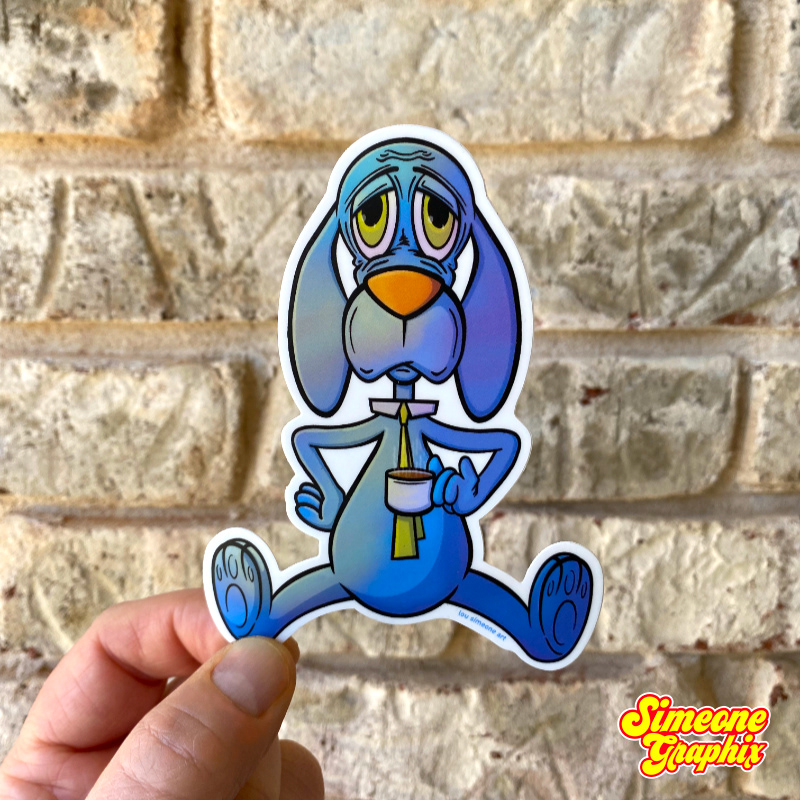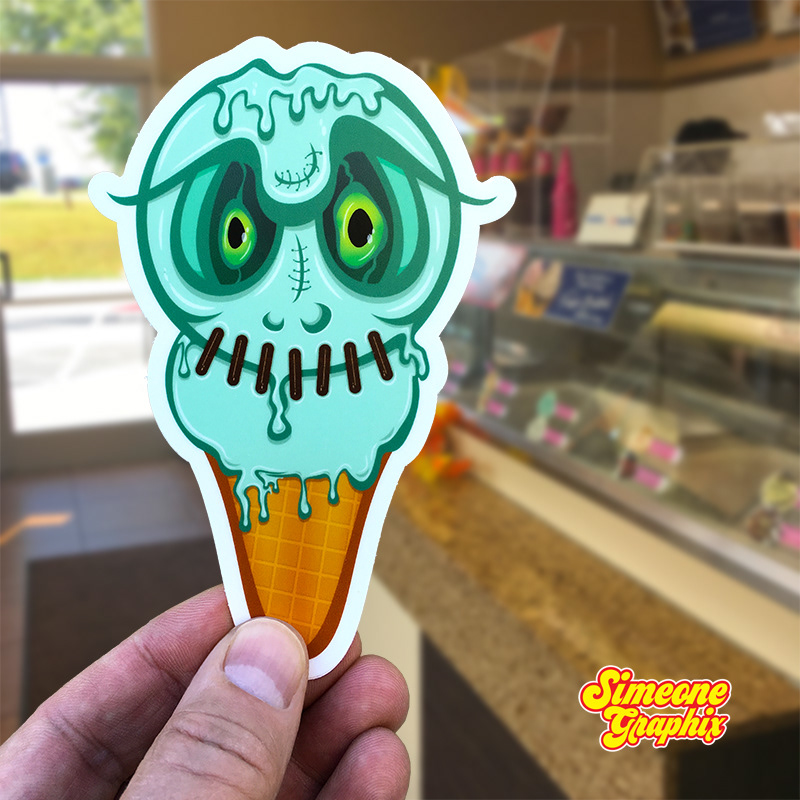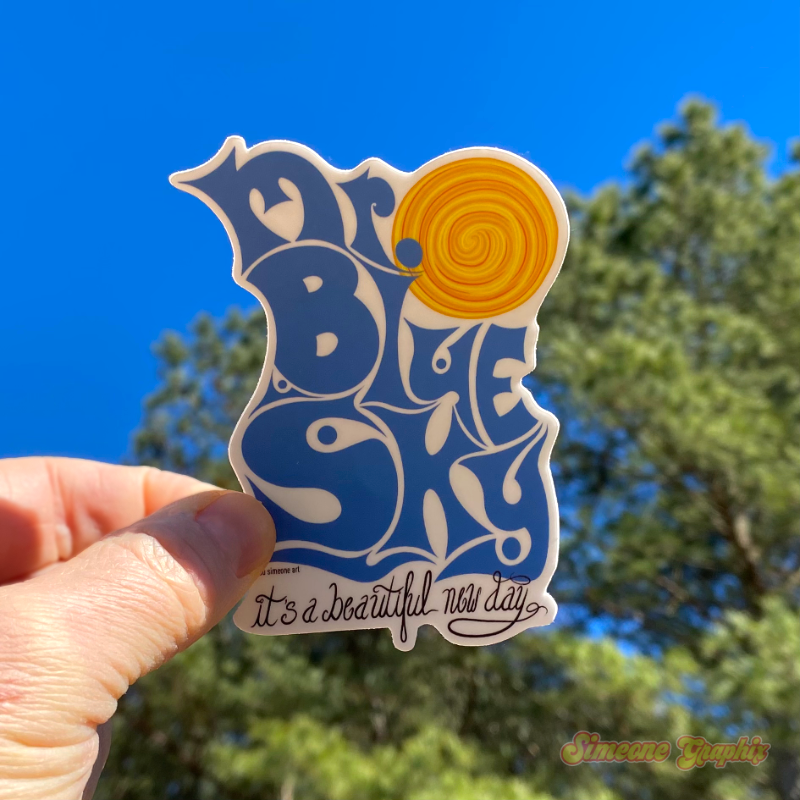8 minute read | Lou Simeone | Simeone Graphix
Stickers have evolved beyond simple decorations; they've become a form of personal expression, a way to adorn everything from laptops to water bottles with unique designs that reflect individual tastes and identities. For artists, creating artwork that sells as stickers can be both creatively fulfilling and financially rewarding. But how do you make artwork that stands out in a crowded market and attracts buyers? Here's a comprehensive guide to help you craft sticker designs that sell.
Designing Your Stickers
Understanding Your Audience and Niche
Knowing your target audience has to be one of the most important things to consider before you lay pencil to paper. Are you designing for kids, teenagers, or adults? What are their interests, hobbies, and aesthetics? Understanding your audience will help you make design choices that resonate with them and create stickers they'll love. It will also prevent you from staring at a blank sheet of paper and wondering what you should start drawing.
Knowing your target audience has to be one of the most important things to consider before you lay pencil to paper. Are you designing for kids, teenagers, or adults? What are their interests, hobbies, and aesthetics? Understanding your audience will help you make design choices that resonate with them and create stickers they'll love. It will also prevent you from staring at a blank sheet of paper and wondering what you should start drawing.
Spotting the Hottest Sticker Trends
When researching sticker trends online, there are a few great ways to stay updated with the latest designs. E-commerce platforms like Etsy and Redbubble provide insights into which stickers are selling well. You can browse their "best sellers" sections or filter by “top-rated” to see what designs resonate with customers. Reading customer reviews can also offer valuable insights into what people love (and dislike) about existing sticker designs, helping you understand current demand.
Social media platforms like Instagram and Pinterest are great for visual inspiration. You can search for hashtags such as #stickershop, #stickerlove, or #stickeroftheday to see what designs people share. Additionally, following sticker artists and shops you admire on social media can provide a good idea of what's popular in the sticker community, including the designs they create, the materials they use, and how they promote their products.
Websites specializing in trend forecasting and product design trends offer a broader view of what's popular in terms of colors, patterns, and aesthetics. By considering the bigger design picture, you can apply those insights to create stickers that align with current trends. However, don't follow trends blindly; find ways to incorporate them into your unique artistic style.
Finally, leveraging search autocomplete on platforms like Google or Etsy can suggest popular search terms. This can be a goldmine for uncovering what stickers people are currently interested in. By using combinations of these methods, you can get a good sense of what's hot in the world of stickers and design your creations accordingly.
The Power of Simplicity
When it comes to sticker designs, simplicity works best. Stickers are often small, and intricate details may not translate well when printed in a small format. Aim for clear, bold designs that are easily recognizable even at a glance. Software like Adobe Illustrator (vector graphics) or Procreate (raster graphics) on the iPad are great for creating clean and scalable artwork. Affinity Photo and Affinity Designer are also excellent choices. Free alternatives like Inkscape (vector) or GIMP (raster) are good options for beginners.
When it comes to sticker designs, simplicity works best. Stickers are often small, and intricate details may not translate well when printed in a small format. Aim for clear, bold designs that are easily recognizable even at a glance. Software like Adobe Illustrator (vector graphics) or Procreate (raster graphics) on the iPad are great for creating clean and scalable artwork. Affinity Photo and Affinity Designer are also excellent choices. Free alternatives like Inkscape (vector) or GIMP (raster) are good options for beginners.




Choose Themes That Resonate
Themes that evoke emotions or align with popular interests tend to sell well. Consider themes like animals, nature, food, pop culture references, and inspirational quotes. These themes have broad appeal and can attract a wide range of buyers. You can also consider creating designs that can be used in various contexts. Designs that can be personalized or customized by the buyer tend to have higher appeal. For example, a sticker with customizable text allows buyers to add their message or name before printing.
Themes that evoke emotions or align with popular interests tend to sell well. Consider themes like animals, nature, food, pop culture references, and inspirational quotes. These themes have broad appeal and can attract a wide range of buyers. You can also consider creating designs that can be used in various contexts. Designs that can be personalized or customized by the buyer tend to have higher appeal. For example, a sticker with customizable text allows buyers to add their message or name before printing.
Exploring Styles and Experimentation
If you're a beginner and haven't developed a unique style yet, that's okay. Your unique style will emerge naturally as you practice. When it comes to artistic direction, there are two schools of thought. Some believe a specific style is unnecessary and that diversity allows you to experiment with different styles, like realism, abstraction, or pop art, potentially appealing to a wider audience. Others argue that a unique style within a specific genre, like horror art, fosters a dedicated following who appreciate your distinct voice and eagerly await your new creations. Ultimately, the choice is yours. Each path offers its rewards.
If you're a beginner and haven't developed a unique style yet, that's okay. Your unique style will emerge naturally as you practice. When it comes to artistic direction, there are two schools of thought. Some believe a specific style is unnecessary and that diversity allows you to experiment with different styles, like realism, abstraction, or pop art, potentially appealing to a wider audience. Others argue that a unique style within a specific genre, like horror art, fosters a dedicated following who appreciate your distinct voice and eagerly await your new creations. Ultimately, the choice is yours. Each path offers its rewards.
Enhance Your Designs with Color
Colors play a crucial role in attracting attention and conveying mood. I opt for vibrant colors that pop, especially for sticker designs intended to be eye-catching. I've also illustrated stickers in grayscale. There are Analogous, Complementary, and Triadic color schemes to name a few. The possibilities are endless. Here are some resources to learn more about color psychology and how to choose colors that evoke specific emotions:
Colors play a crucial role in attracting attention and conveying mood. I opt for vibrant colors that pop, especially for sticker designs intended to be eye-catching. I've also illustrated stickers in grayscale. There are Analogous, Complementary, and Triadic color schemes to name a few. The possibilities are endless. Here are some resources to learn more about color psychology and how to choose colors that evoke specific emotions:
Color Psychology: Does It Affect How You Feel? (article published in 2024)
The Fundamentals of Color Psychology (article published in 2023)
Mastering Composition
Composition is the arrangement of elements within your design. A well-balanced composition guides the viewer's eye and creates visual harmony. Experiment with different layouts and compositions to find what works best for your design. If you opt for something wacky, make sure it looks intentional. Wacky can be fun and interesting as long as it looks intentional. You should know the rules, (focus, balance, scale, etc.) before attempting to break the rules.
Composition is the arrangement of elements within your design. A well-balanced composition guides the viewer's eye and creates visual harmony. Experiment with different layouts and compositions to find what works best for your design. If you opt for something wacky, make sure it looks intentional. Wacky can be fun and interesting as long as it looks intentional. You should know the rules, (focus, balance, scale, etc.) before attempting to break the rules.
Testing Your Designs
Once you have a few designs, you might want to test them before mass production. Here are some ways to get feedback:
Once you have a few designs, you might want to test them before mass production. Here are some ways to get feedback:
• Print a small batch to sell online to see how well they do.
• Sell them at local craft fairs and get in-person feedback.
• Share your designs on social media and ask for feedback from your followers. (This can have mixed results)
• Sell them at local craft fairs and get in-person feedback.
• Share your designs on social media and ask for feedback from your followers. (This can have mixed results)
Navigating Legalities
It's important to check for copyright and trademark restrictions before using popular characters, logos, or quotes in your designs. Selling copyrighted material without permission can lead to legal trouble.
It's important to check for copyright and trademark restrictions before using popular characters, logos, or quotes in your designs. Selling copyrighted material without permission can lead to legal trouble.
Printing Your Stickers
Choosing the Right Printing Methods
Professional sticker printers usually use high-resolution inkjet or laser printing techniques to create stickers. Inkjet printing offers vibrant colors, while laser printing excels in sharp text and crisp details. After printing, a matte or glossy laminate is applied to increase the durability of the sticker, making it weather-resistant. Some professional printers may also offer screen printing for smaller runs with unique designs, creating vibrant colors and thick textures.
Considering Sticker Material and Finish
The material and finish of the stickers will impact their appearance and functionality. Options include vinyl (durable and weatherproof), paper (economical and versatile), polyester (tear-resistant), and eco-friendly alternatives. Different finishes such as glossy for a shiny, eye-catching look, matte for a more subdued and professional feel, and holographic or metallic finishes for a unique touch are also available.
The material and finish of the stickers will impact their appearance and functionality. Options include vinyl (durable and weatherproof), paper (economical and versatile), polyester (tear-resistant), and eco-friendly alternatives. Different finishes such as glossy for a shiny, eye-catching look, matte for a more subdued and professional feel, and holographic or metallic finishes for a unique touch are also available.
Understanding Order Requirements and Printer Reputation
Some printers have minimum order requirements, such as 50 - 100 stickers, while others offer the option to order small samples in quantities ranging from 8 to 25. Rush options may be available for an additional cost, so consider how quickly you need your stickers. Lastly, it's important to consider the printer's reputation. Research online reviews and testimonials to assess the printer's quality, customer service, and overall reputation.
Some printers have minimum order requirements, such as 50 - 100 stickers, while others offer the option to order small samples in quantities ranging from 8 to 25. Rush options may be available for an additional cost, so consider how quickly you need your stickers. Lastly, it's important to consider the printer's reputation. Research online reviews and testimonials to assess the printer's quality, customer service, and overall reputation.
Packaging, Pricing, and Promoting Your Stickers
Elevating Your Packaging
Packaging plays a significant role in the perceived value of your stickers. Consider how your designs will be presented to the buyer. Investing in attractive packaging can make your stickers more appealing and increase their perceived value. It also helps prevent your stickers from getting damaged during the shipping process. Going the extra mile with this detail can set you apart from others. Some artists go as far as to include a small freebie with each purchase or offer a discount on the next purchase. These are things that keep customers coming back. And they're often mentioned in the reviews.
Packaging plays a significant role in the perceived value of your stickers. Consider how your designs will be presented to the buyer. Investing in attractive packaging can make your stickers more appealing and increase their perceived value. It also helps prevent your stickers from getting damaged during the shipping process. Going the extra mile with this detail can set you apart from others. Some artists go as far as to include a small freebie with each purchase or offer a discount on the next purchase. These are things that keep customers coming back. And they're often mentioned in the reviews.
Pricing and Selling Strategies
Consider factors like production costs, materials, and your desired profit margin when setting prices. Research what similar stickers are selling on various platforms to stay competitive. There are different ways to sell your stickers. Popular options include online marketplaces like Etsy, Redbubble, or Society6, which will have selling and transaction fees to consider when setting your prices. You can also sell through your website or at local craft fairs and events. Remember, offering your stickers at bargain-basement prices isn't a guaranteed way to make a sale. Customers will naturally question the quality of your product if the prices seem unusually low. You'll also be doing yourself an injustice if you're not making the profits you could be making. People are often willing to pay for something they love, and many prefer to support small businesses and independent artists rather than large retailers and corporations. Pricing can be like a high-wire act, you need to find a good balance.
Consider factors like production costs, materials, and your desired profit margin when setting prices. Research what similar stickers are selling on various platforms to stay competitive. There are different ways to sell your stickers. Popular options include online marketplaces like Etsy, Redbubble, or Society6, which will have selling and transaction fees to consider when setting your prices. You can also sell through your website or at local craft fairs and events. Remember, offering your stickers at bargain-basement prices isn't a guaranteed way to make a sale. Customers will naturally question the quality of your product if the prices seem unusually low. You'll also be doing yourself an injustice if you're not making the profits you could be making. People are often willing to pay for something they love, and many prefer to support small businesses and independent artists rather than large retailers and corporations. Pricing can be like a high-wire act, you need to find a good balance.
Promoting Your Artwork
Once your stickers are ready for sale, here are some ways to effectively promote them and reach potential buyers.
Once your stickers are ready for sale, here are some ways to effectively promote them and reach potential buyers.
Maximizing Social Media Marketing: Create engaging profiles on Instagram, Pinterest, and TikTok. Regularly post high-quality images and videos showcasing your stickers in use. Utilize relevant hashtags and run targeted social media ad campaigns to reach a wider audience interested in stickers.
Leveraging Content Marketing: Start a blog or YouTube channel where you share behind-the-scenes glimpses of your creative process, sticker design tutorials, or collaborations with other artists. This content will establish you as an expert in the sticker design space and attract potential customers.
Influencer Marketing: Partner with social media influencers with an audience that aligns with your target market. Offer them free stickers or collaborate on a limited-edition design. Influencers can promote your stickers to their followers through product reviews, creative content featuring your stickers, giveaways or contests, and discount codes. Building genuine relationships with influencers is key to successful influencer partnerships.
Creating artwork for stickers that sell requires creativity, market research, and attention to detail. By understanding your audience, staying updated with trends, and focusing on simplicity and versatility, you can design stickers that appeal to a wide range of buyers. Experiment with different styles, colors, and themes, and don't forget to test your designs before production. With the right approach, your sticker designs can become sought-after items that resonate with customers and bring joy wherever they're placed.
You might also like the articles below:
Love stickers and appreciate independent art? Check out my collection of unique stickers in my shop!
